7.3 Freshwater Supply
Freshwater Supply
Primary Fresh Water Resources: Precipitation
Precipitation levels are unevenly distributed around the globe, affecting freshwater availability (Figure 1). More precipitation falls near the equator, whereas less precipitation tends to fall near 30 degrees north and south latitude, where the world’s largest deserts are located. These rainfall and climate patterns are related to global wind circulation cells. The intense sunlight at the equator heats the air, causing it to rise and cool, which decreases the ability of the air mass to hold water vapor and results in frequent rainstorms. Around 30 degrees north and south latitude, descending air conditions produce warmer air, which increases its ability to hold water vapor and results in dry conditions. The dry air conditions and the warm temperatures of these latitude belts favor evaporation. Global precipitation and climate patterns are also affected by the size of continents, major ocean currents, and mountains.
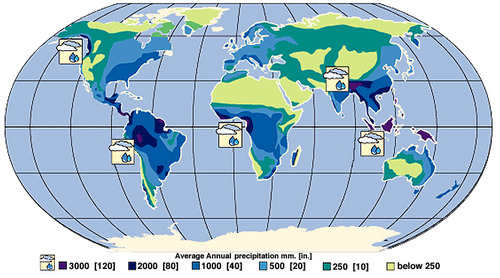
Surface Water Resources: Drainage Basins and Rivers
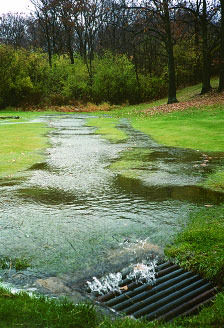
Flowing water from rain and melted snow on land enters river channels by surface runoff (Figure 2) and groundwater seepage (Figure 3). River discharge describes the volume of water moving through a river channel over time (Figure 4). The relative contributions of surface runoff vs. groundwater seepage to river discharge depend on precipitation patterns, vegetation, topography, land use, and soil characteristics. Soon after a heavy rainstorm, river discharge increases due to surface runoff. The steady normal flow of river water is mainly from groundwater that discharges into the river. Gravity pulls river water downhill toward the ocean. Along the way, the moving water of a river can erode soil particles and dissolve minerals. Groundwater also contributes a large amount of the dissolved minerals in river water.
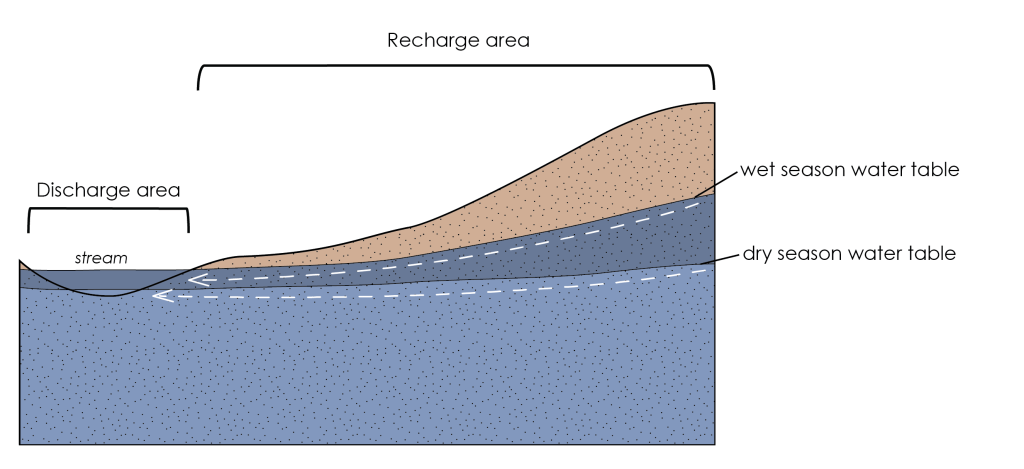
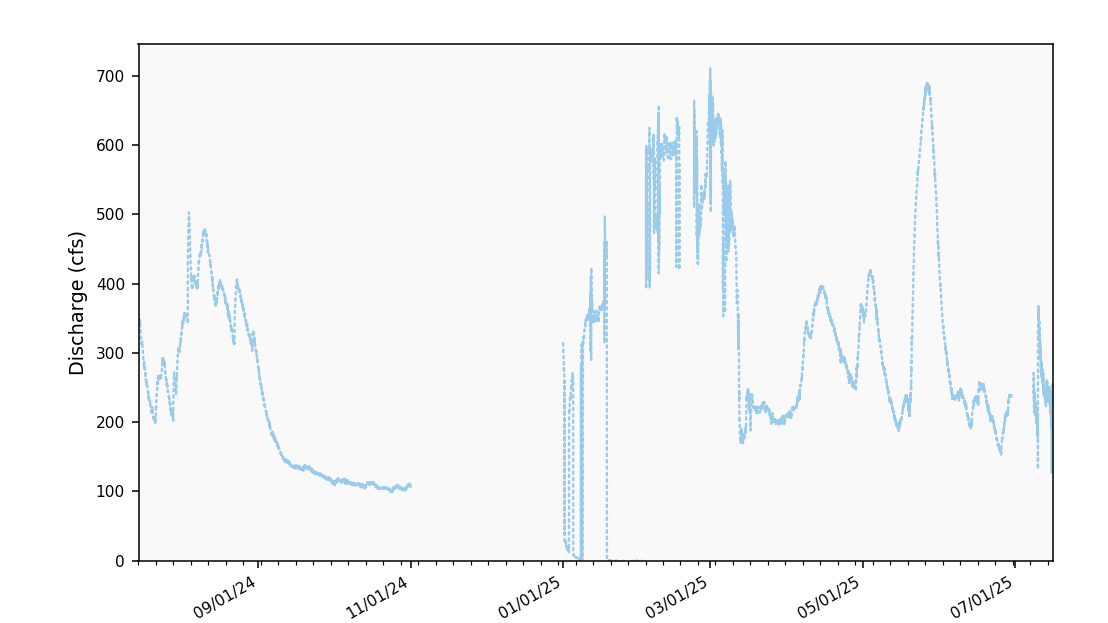
The area from which water flows to form a stream is known as its drainage basin (interchangeably referred to as a watershed in North America). All the precipitation (rain or snow), plus any meltwater or discharging groundwater within this area will eventually flows into its stream and then on to the final destination (typically the ocean), unless some of that water infiltrates into the ground, in which case, it may flow as groundwater into a different watershed. Neighboring watersheds are separated from each other by higher ridges and peaks on the landscape called drainage divides (Figure 5).

Watersheds can be discussed at different scales, and can be small, such as several small trickles coming together to make a small creek, or large, such as big rivers (and their associated tributaries) that come together to make a major river. The Mississippi-Missouri Watershed is the largest in the U.S. (and 3rd largest in the world!). It includes approximately 40% of the U.S., a measure that includes the smaller drainage basins, such as the Ohio River and Missouri River, that contribute to it. Within it there are several smaller watersheds, and those contain yet smaller watersheds. The water that falls within these watersheds eventually makes it to the Gulf of Mexico (Figure 6). Continental divides are major drainage divides that separate watersheds that flow to different water bodies (e.g., to Gulf of Mexico versus Atlantic Ocean vs. Pacific Ocean).
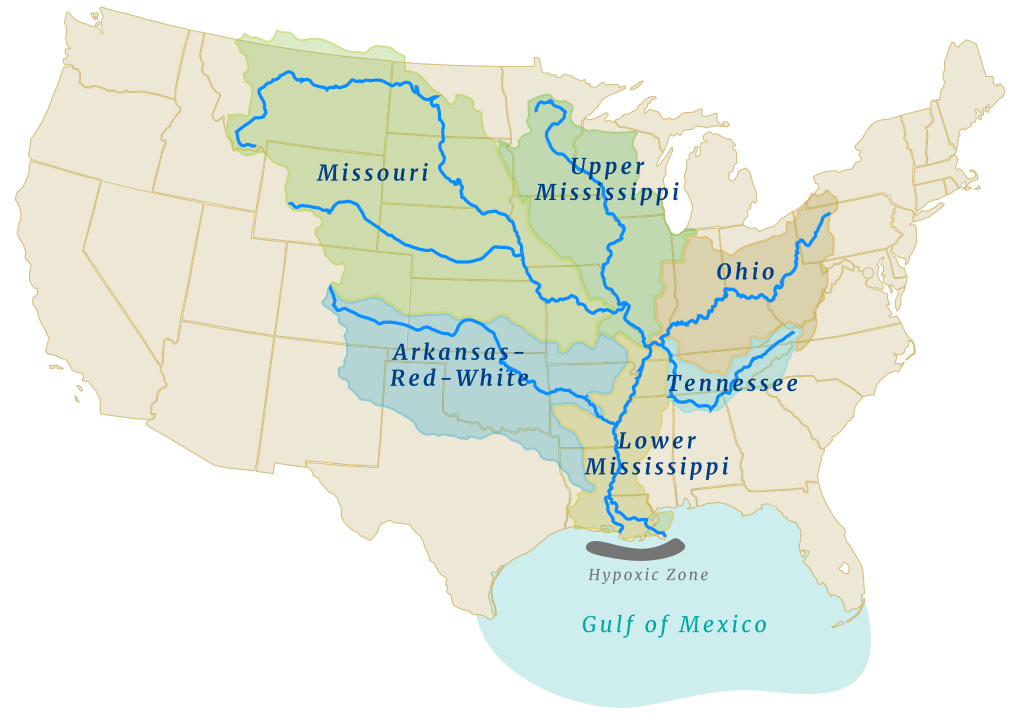

 Surface Water Resources: Lakes
Surface Water Resources: Lakes
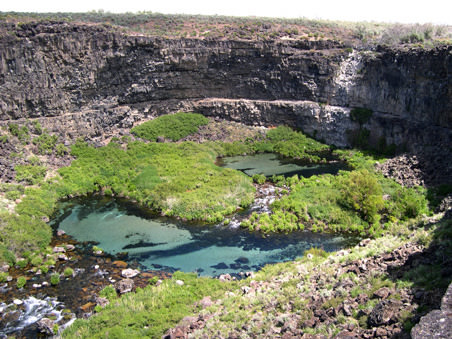
Surface Water Resources: Glaciers
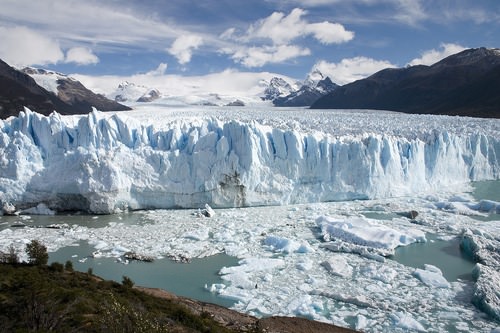
Groundwater Resources
Although most people worldwide use surface water, groundwater is a much larger reservoir of usable fresh water, containing more than 30 times more water than rivers and lakes combined. Groundwater is a particularly important resource in arid climates, where surface water may be scarce. In addition, groundwater is the primary water source for rural homeowners, providing 98% of that water demand in the U.S.
Porosity and Permeability
Groundwater is water located in small spaces, called pore space, between mineral grains and fractures in subsurface earth materials (rock or sediment). Different rocks and sediments have different amounts of pore space in them. The porosity of a material is a measure of the percentage or amount of pore space compared to the total volume of rock or sediment.

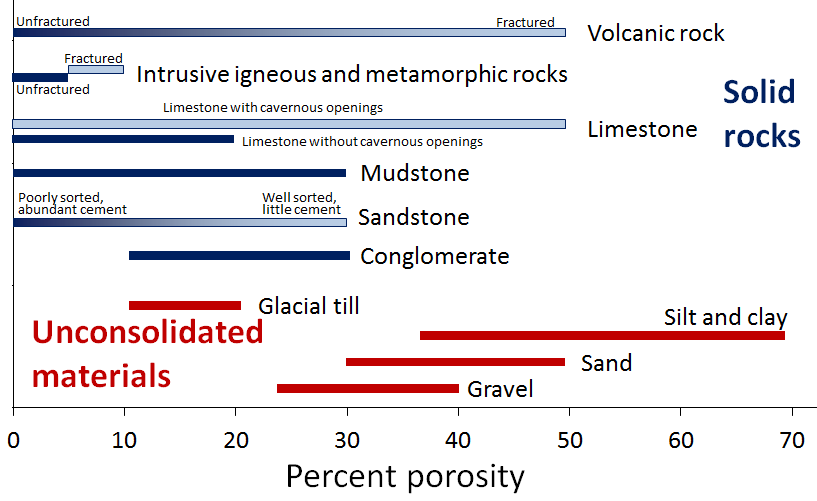
Just because a rock or sediment can hold a lot of water (i.e., has high porosity) does not mean the water can easily flow through the rock. The ability of water to flow through the rock is called permeability. Permeability is a measure of the size and how well connected the pore space in a rock or sediment is and therefore how easily water can move from one pore space to the next.
Smaller pores (not sediment size!) typically mean more twists and turns for the water to have to flow-through which impedes its ability to flow, and if the pore space is not connected at all, then there is not an available path to get through the material. Permeable materials have a greater number of larger, well-connected pores spaces, whereas low permeability (low connectivity and flow) or impermeable (no connectivity or flow) materials have fewer, smaller pores that are poorly (or not) connected.
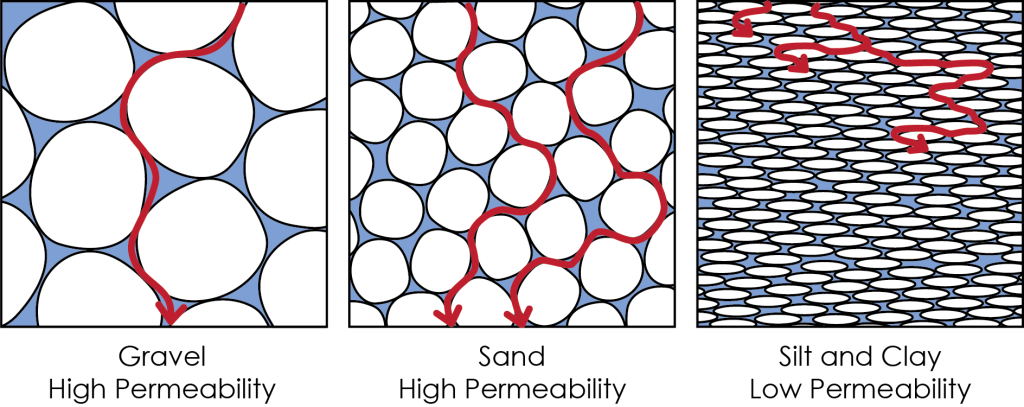
Relative permeabilities are shown in Figure 12 below. Permeabilities of rocks are shown in blue and unconsolidated sediments are shown in red. Some sediments like gravel and sand have high porosity (Figure 9) and high permeability. Other sediments like clay have high porosity but very low permeability. Fractured igneous and metamorphic rock has low porosity but can have quite high permeability! This means that the fracturing may not make a lot of open space in these rocks, but the open space it does make is very well connected.
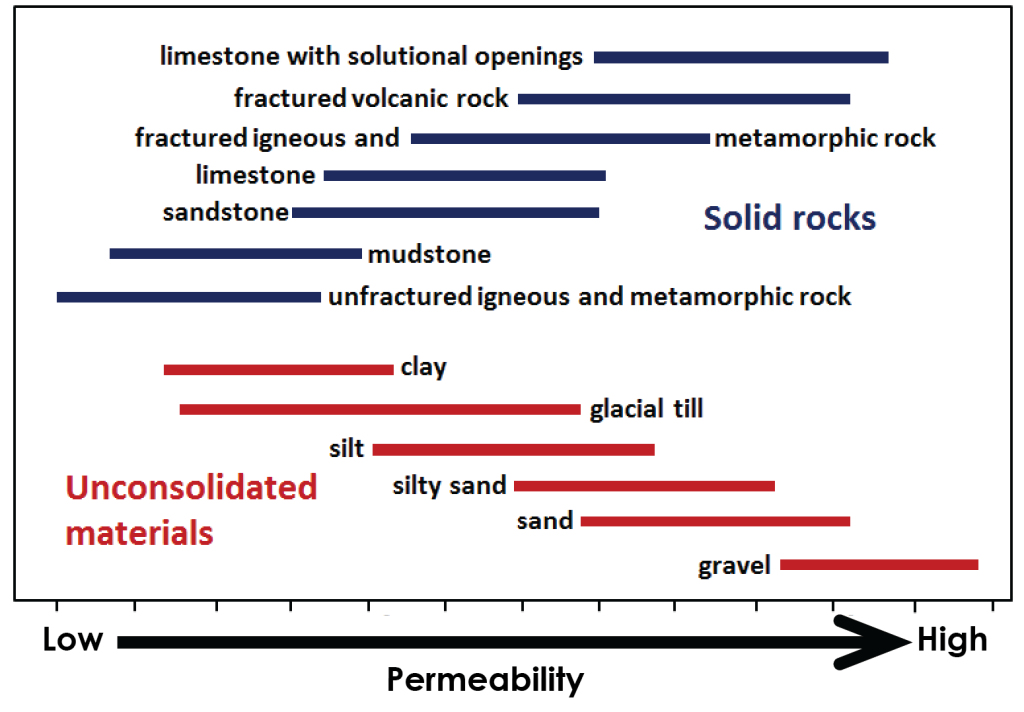
Water Table, Aquifers, and Aquicludes
Most groundwater originates on the surface as rain or snowmelt, infiltrating the ground and moving downward. As water travels downwards, it is moving through an area of rock or soil where the pore space is broadly filled with air. This is the unsaturated zone. Water continues to move downwards until it reaches rock and sediment where all the pore space is filled with water. This is the saturated zone.

The surface of the saturated zone is called the water table. It is the boundary between the unsaturated and saturated rocks and sediments. Note there is a small zone on top of the water table where the rock and sediment are neither fully saturated nor unsaturated. This is the capillary fringe, and it is the transition from the unsaturated to saturated zones. The water table is located at the base of the capillary fringe.
As water works its way below the water table, it will collect and flow differently in different rock and sediment types based on their porosity and permeability. The name for a body of rock or sediment that has high porosity and high permeability is an aquifer. This is the rock or sediment a groundwater well is put into. Unconsolidated materials like gravel and sand, and rocks like sandstone make good aquifers. Other rocks can be good aquifers if they are well fractured. Aquifers are commonly drilled, and wells are installed to provide water for agriculture and personal use.
An aquiclude is a layer of impermeable geologic material that does not allow groundwater to flow through it. An aquifer where there is an aquiclude layer between it and the ground surface is called a confined aquifer, and the aquiclude separating it from the ground surface is known as the confining layer (Figure 14). Water in a confined aquifer can be pressurized. Artesian springs (natural) and artesian wells (manmade) occur where the water is pressurized enough that the water will push its way up to flow out at the ground surface through any available conduit (a fracture in the ground or a well pipe, respectively) without needing to be pumped.
An aquifer where the water table sits within the overall package or layer of rocks that make up the aquifer is called an unconfined aquifer. There is no aquiclude layer between an unconfined aquifer and the ground surface so the water within an unconfined aquifer is at atmospheric pressure. There can only be one unconfined aquifer but many confined aquifers at any location under the ground.
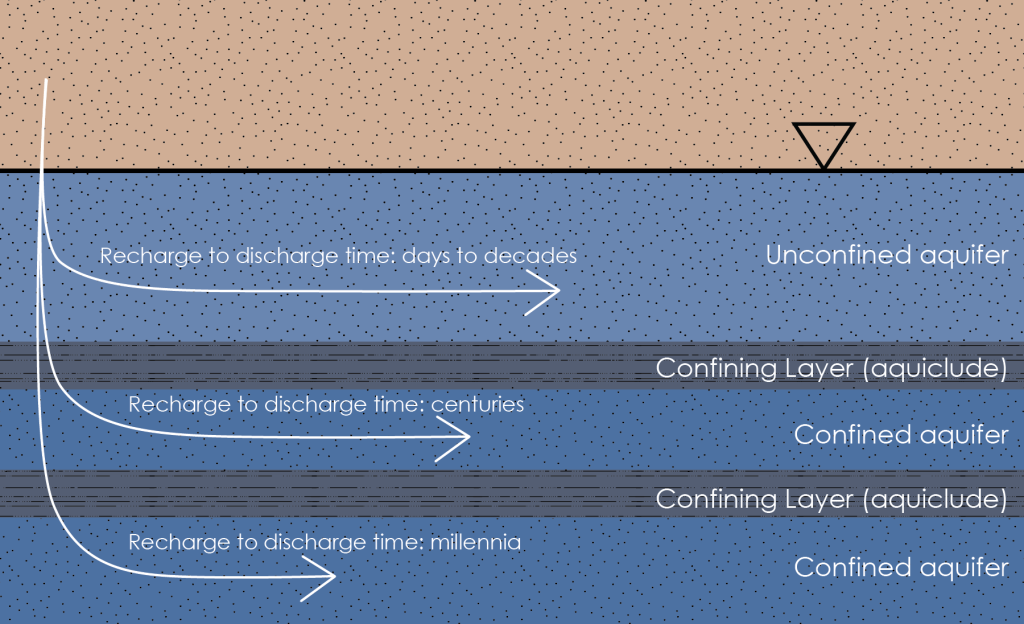
In addition to precipitation infiltrating from the surface, other groundwater sources include seepage from surface water (lakes, rivers, reservoirs, and swamps), surface water deliberately pumped into the ground, irrigation, and underground wastewater treatment systems (septic tanks). Water infiltrates down to the aquifer where it flows as groundwater, this is called groundwater recharge (the water is recharging or refilling the groundwater). Recharge areas are locations where surface water infiltrates the ground, rather than running into rivers or evaporating. Wetlands, for example, are excellent recharge areas. Eventually groundwater will flow to an area where it will discharge back into surface water or the ocean (the water is discharging or leaving the ground).
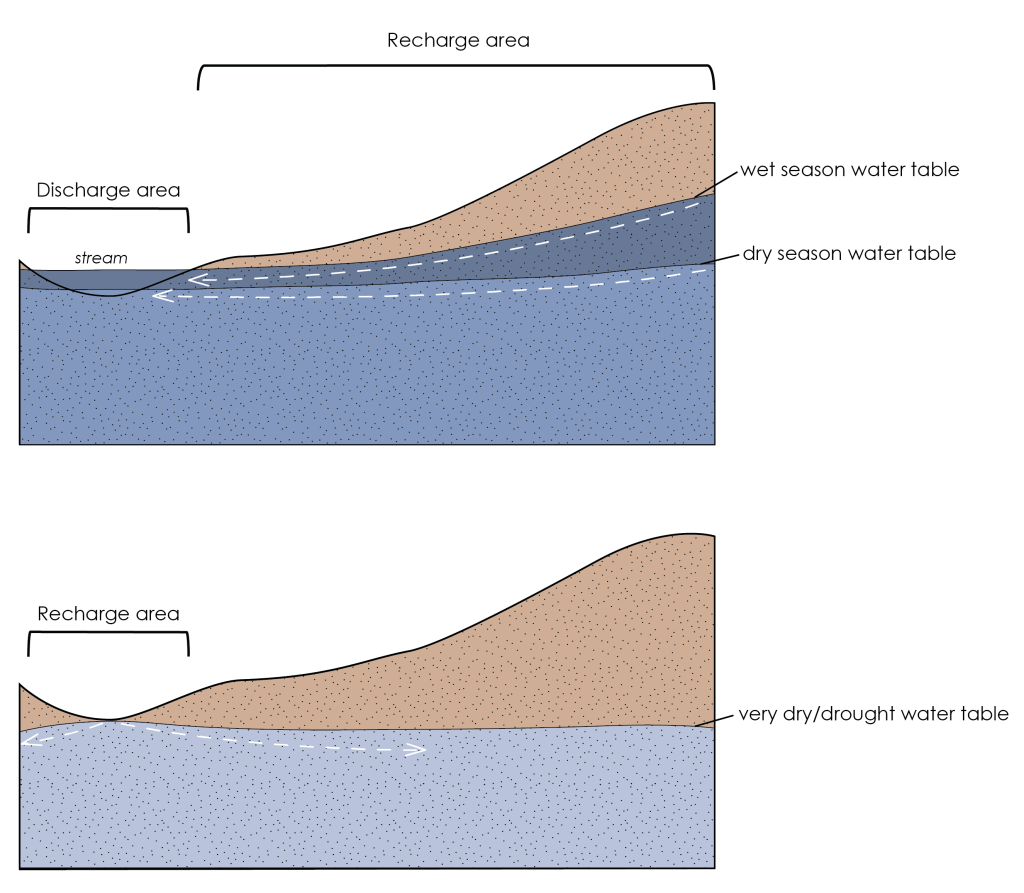
The flow rate of groundwater is very slow compared to surface water. It ranges from a foot per day at the fast end down to a foot per year or even a foot per decade depending on the permeability of the material it is flowing through. To put this in comparison, an average river flow is in the range of 1-3 feet per second (over 16 miles per day). This means the time that water spends in the ground from recharge to discharge can be very long. Groundwater that flows through the surface unconfined aquifer will spend the least amount of time underground, anywhere from days to decades. Groundwater that travels into deeper confined aquifers can spend much longer underground, anywhere from centuries to millennia before discharging (Figure 14).
Discussion:
- Rivers that have had international disputes over water supply include Colorado (Mexico, southwest U.S.), Nile (Egypt, Ethiopia, Sudan), Euphrates (Iraq, Syria, Turkey), Ganges (Bangladesh, India), and Jordan (Israel, Jordan, Syria).
- In the upper Midwest of the U.S., specifically in the Red River of the North basin, watershed districts and water resource districts are local government agencies which have been created in Minnesota and North Dakota (respectively) to help minimize water disputes between landowners and land managers. With the Red River flowing northward into Manitoba, Canada, the International Joint Commission works to coordinate management of such waterways between the Canada and U.S.
- Research other water volume challenges and disputes, such as:
- White Bear Lake, MN: https://www.mprnews.org/story/2017/08/30/judge-rebukes-dnr-white-bear-lake-levels
- Why does the Red River of the North flood so often? What are the causes? What have been some significant flooding events on this river? What is being done to address flooding and the causes and effects of floods?
- The Ogallala Aquifer of the U.S. Great Plains
- The history of water resource management in Los Angeles, including Lake Mead and the Colorado River
Attribution:
Portions of this section are cloned from:
- Introduction to Environmental Sciences and Sustainability, by Emily P. Harris, University of West Florida, published using Pressbooks, under a CC BY (Attribution) license.
- Environmental Geology, by Lindsay J. Iredale, Normandale Community College, published using Pressbooks, under a CC BY-NC.SA 4. (Attribution-NonCommercial-ShareAlike 4.0 International; https://creativecommons.org/licenses/by-nc-sa/4.0/)
Media Attributions
- recharge-discharge-areas-1024×893
- hydrograph_cgi
- Private: drainage basins
- Private: porosity © Lindsay Iredale is licensed under a CC BY (Attribution) license
- Private: Permeability © Lindsay Iredale is licensed under a CC BY (Attribution) license
- Private: Permeability from Earle
- Private: saturated unsaturated water table
- Private: confined and unconfined1
- Private: recharge discharge areas
